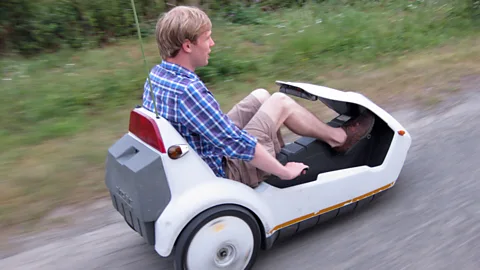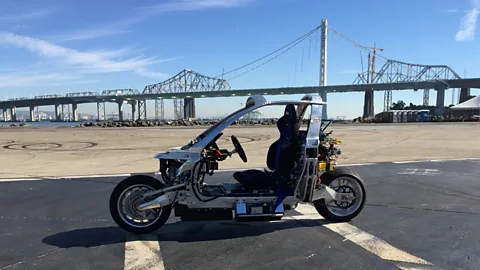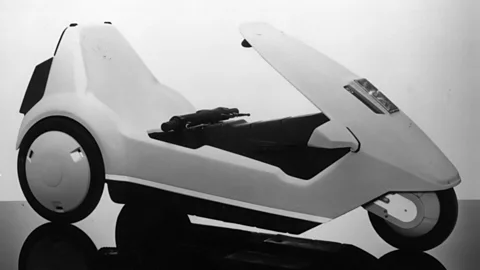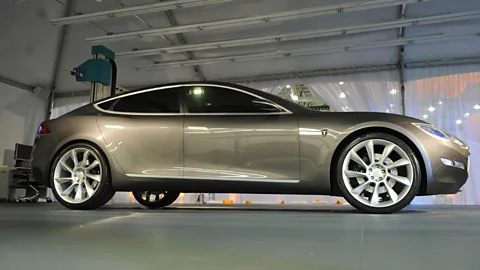Was the Sinclair C5 30 years too early?


In 1985, British entrepreneur Sir Clive Sinclair unveiled the electrically powered pedal car the C5. It was a disastrous failure. But was it also ahead of its time?
The road to the future is, apparently, always under construction. Its hard shoulder is littered with automotive relics that did not make it. Sometimes a wacky design is the cause of their downfall. Sometimes it’s the strange propulsion system. Or sometimes, as with the Sinclair C5, it’s an unfortunate combination of the two.
The C5 electric tricycle (with pedal assist) was a single-seater vehicle unveiled with great fanfare on 10 January 1985. It was billed as the future of transport. A non-polluting machine, capable of taking a driver wherever they needed to go: the shops, to work, or to a train station. It would replace oversized, under-efficient cars.
At the time of its launch, there was a great deal of hope (if not hype) around the vehicle. Take, for instance this report from BBC World Service’s Science in Action. Note the reporter, Dick Oliver’s, very British way of expressing joy.
“If the advertising budget is anything to go by, we’ll be seeing quite a lot of these things around,” says Oliver.
It just goes to show you that sometime success just can’t be bought.
Along with the DeLorean (which gained fame in the Back to the Future movies), Sir Clive Sinclair’s C5 not only ranks as one of the most spectacular transport failures of 1980s, but it also has the dubious distinction of being named the worst gadget of all time – ahead of Betamax videos and pizza scissors.
But what strikes me is that 30 years later the drive to create more personal transport is on the rise. Witness the Lit Motors C1 I got to test drive a couple of weeks ago. The visual similarities are startling.

So perhaps Sinclair’s idea of personal transport was just decades before its time. And in order not to repeat the mistakes of the past, what went wrong with it, and what can we learn?
Sinclair was known for being at the forefront of British innovation for many years by the time he tried his hand at vehicles. He had invented pocket radios, pocket TVs, electronic watches, and Britain’s biggest-selling home computer. Many millions of pounds worth of development went into the C5. It had a cutting-edge injection-moulded polypropylene shell (claimed to be the largest in the world), and a chassis designed by Lotus. It had a battery that could provide an 18.7-mile (30 kilometre) range, at up to 15mph (25km/h). Steering was done with handlebars under the rider’s legs as they leaned back. All of which sounds impressive on paper, and then you see the product in action…

The C5 had an almost instant image problem. The press and public saw the C5 less as a new mode of transport, and more as a toy – and an expensive one at that. Yours for only £399 (£1,120), and if you wanted to go uphill, you would have to pedal. But the C5 went from drawing board to prototype without any market research, according to Andrew Marks, who wrote an investigation into the vehicle’s failure for the European Journal of Marketing four years after the C5 was released. Sir Clive believed he could create a market where none had existed before, using changes in legislation that allowed electric pedal vehicles and improving battery technology. But, as Marks argues, the C5 programme seemed to be dictated by the company’s conviction, rather than by public demand.
The C5 was also immediately criticised for its safety, or lack thereof. “I don’t like the ideas of driving it in traffic, frankly,” says Oliver in the report. The driving position was extremely low, making it effectively invisible to other vehicles. It could also be operated by anyone over 14 years old in the UK, without a license or helmet. Famed racing driver Stirling Moss expressed his concerns too.
“If people get into it and in any way think that they’re in a car because they’re sitting down, then they’re in trouble.”

Media reviews were also harsh about the range – the battery did not live up to expectations – and there was too much exposure to the elements. In retrospect a January launch in London may not have been the most enticing demonstration to carry out. The poor reception meant orders were minimal, and production ceased around eight months later.
The Sinclair C5 did have a hi-tech “silicon chip control system” to monitor the battery charge and electric motor temperature, and to tell the driver when to add some pedal assistance. The trouble is, that turned out to be far too often.
Despite almost universal derision, the C5 still has a cult following. Parts are available on online auction sites and there are owners clubs swapping advice. A fully working C5 would set you back around £650 ($1,000) on eBay. The C5’s plastic body panels have weathered the passing of three decades much better than most steel cars.

In the decades since, battery technology has improved, as have electronic control systems for safety and stability. The appetite for alternatives to petrol-engined cars is growing, with some electric vehicles such as the Tesla Model S, and the Nissan Leaf becoming sales success stories. And cycling is also increasingly popular in cities, some of which have plans to ban cars all together.
Perhaps a version of the C5, if it were to be introduced now, would also be a success.
